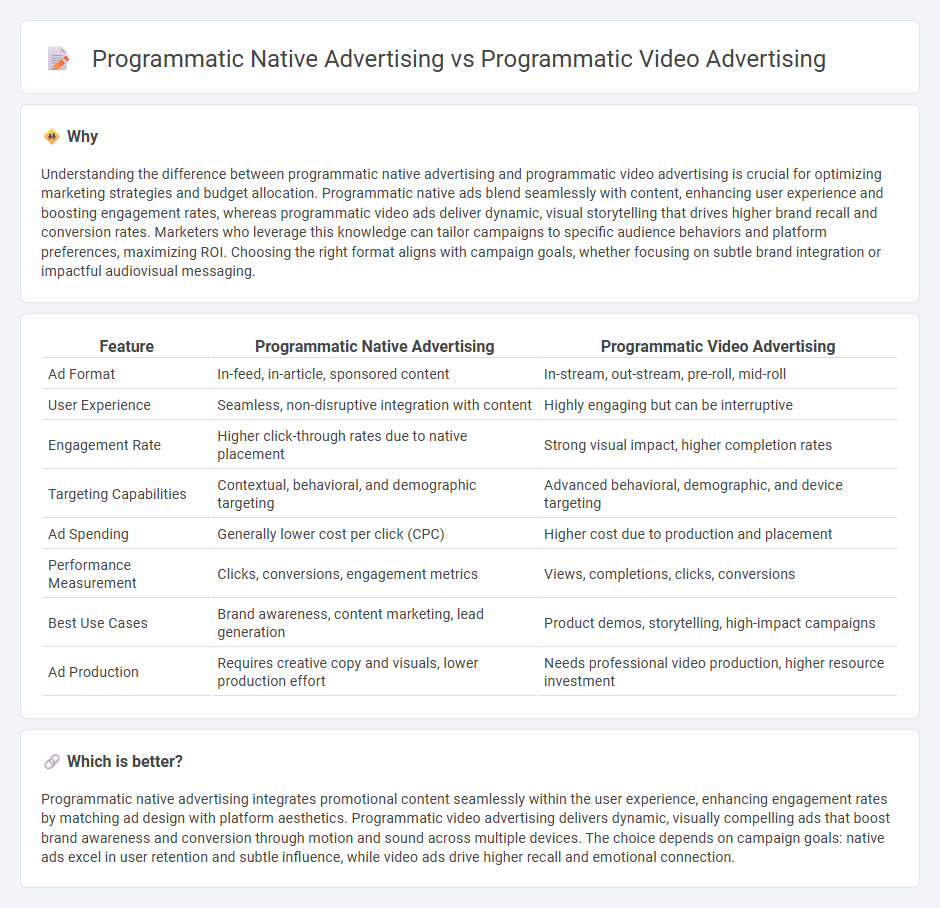
Programmatic native advertising seamlessly integrates promotional content within website layouts, enhancing user engagement by matching the ad format to the platform's design, while programmatic video advertising delivers targeted video ads across digital channels to captivate audiences with dynamic visual storytelling. Both strategies leverage automated bidding and data analytics to optimize ad placement and improve ROI. Explore detailed insights to understand which approach best suits your marketing goals.
Why it is important
Understanding the difference between programmatic native advertising and programmatic video advertising is crucial for optimizing marketing strategies and budget allocation. Programmatic native ads blend seamlessly with content, enhancing user experience and boosting engagement rates, whereas programmatic video ads deliver dynamic, visual storytelling that drives higher brand recall and conversion rates. Marketers who leverage this knowledge can tailor campaigns to specific audience behaviors and platform preferences, maximizing ROI. Choosing the right format aligns with campaign goals, whether focusing on subtle brand integration or impactful audiovisual messaging.
Comparison Table
| Feature | Programmatic Native Advertising | Programmatic Video Advertising |
|---|---|---|
| Ad Format | In-feed, in-article, sponsored content | In-stream, out-stream, pre-roll, mid-roll |
| User Experience | Seamless, non-disruptive integration with content | Highly engaging but can be interruptive |
| Engagement Rate | Higher click-through rates due to native placement | Strong visual impact, higher completion rates |
| Targeting Capabilities | Contextual, behavioral, and demographic targeting | Advanced behavioral, demographic, and device targeting |
| Ad Spending | Generally lower cost per click (CPC) | Higher cost due to production and placement |
| Performance Measurement | Clicks, conversions, engagement metrics | Views, completions, clicks, conversions |
| Best Use Cases | Brand awareness, content marketing, lead generation | Product demos, storytelling, high-impact campaigns |
| Ad Production | Requires creative copy and visuals, lower production effort | Needs professional video production, higher resource investment |
Which is better?
Programmatic native advertising integrates promotional content seamlessly within the user experience, enhancing engagement rates by matching ad design with platform aesthetics. Programmatic video advertising delivers dynamic, visually compelling ads that boost brand awareness and conversion through motion and sound across multiple devices. The choice depends on campaign goals: native ads excel in user retention and subtle influence, while video ads drive higher recall and emotional connection.
Connection
Programmatic native advertising and programmatic video advertising both utilize automated technology to deliver highly targeted, contextually relevant ads to specific audiences in real-time, enhancing engagement and conversion rates. Programmatic native ads seamlessly blend into content formats, while programmatic video ads leverage rich media to capture attention through dynamic storytelling. Together, they optimize digital marketing strategies by combining contextual relevance with compelling visual experiences, driving higher ROI across platforms.
Key Terms
Real-Time Bidding (RTB)
Programmatic video advertising leverages Real-Time Bidding (RTB) to deliver targeted video ads to specific audiences across connected devices, enhancing user engagement and campaign efficiency. Programmatic native advertising also utilizes RTB but integrates ads seamlessly within content feeds, providing a less intrusive and more personalized user experience. Explore how RTB optimizes both formats to maximize ad relevance and ROI.
Ad Format
Programmatic video advertising delivers dynamic, engaging video content across display, social, and streaming platforms, leveraging rich media to capture viewer attention and boost brand recall. Programmatic native advertising seamlessly integrates sponsored content into the user experience, matching the look and feel of the surrounding editorial environment to enhance relevance and reduce ad fatigue. Explore the unique attributes of both formats to optimize your digital marketing strategy and maximize ROI.
User Engagement
Programmatic video advertising leverages dynamic, personalized video content delivered across multiple platforms to capture user attention through visual storytelling, resulting in higher engagement rates and longer watch times. In contrast, programmatic native advertising seamlessly integrates promotional content within the user's natural browsing environment, enhancing engagement by maintaining a non-disruptive, contextually relevant experience. Explore more to understand how these advertising strategies can optimize user engagement and drive marketing success.
Source and External Links
Programmatic Video Advertising (Amazon) - Programmatic video advertising is the automated, auction-based buying and selling of video ad inventory in real time through demand-side and supply-side platforms, allowing advertisers to efficiently target specific audiences by leveraging algorithms and data signals for ad placements across web, mobile, apps, and streaming services.
Programmatic Video Advertising (Wyzowl) - Programmatic video advertising uses automated systems and preset requirements to purchase the right video ad space for your target audience, with bidding and placement happening in milliseconds as a webpage loads, delivering highly relevant ads without manual intervention.
Programmatic Video Advertising (SmartyAds) - Programmatic video advertising employs algorithmic technology and AI to purchase video ad impressions exclusively for targeted users, offering real-time optimization, extensive audience targeting, and increasing automation in the online video ad space.
 dowidth.com
dowidth.com